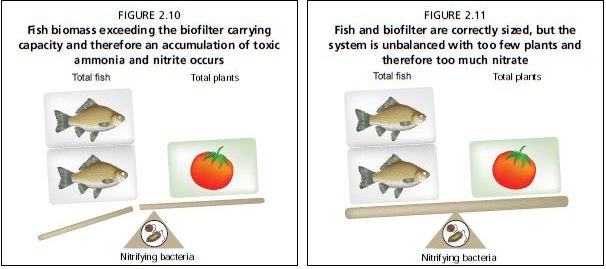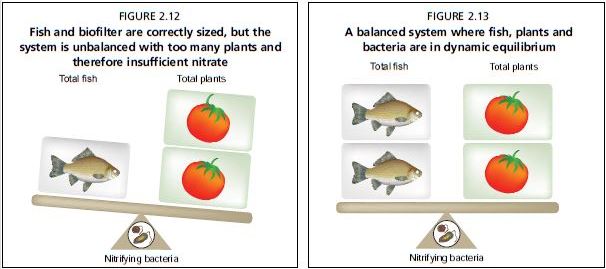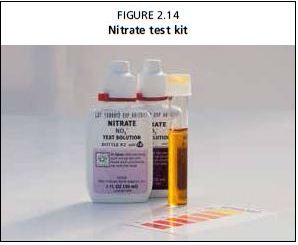2.4 BALANCING THE AQUAPONIC ECOSYSTEM
The term balancing is used to describe all the measures an aquaponic farmer takes to ensure that the ecosystem of fish, plants and bacteria is at a dynamic equilibrium. It cannot be overstated that successful aquaponics is primarily about maintaining a balanced ecosystem. Simply put, this means that there is a balance between the amount of fish, the amount of plants and the size of the biofilter, which really means the amount of bacteria. There are experimentally determined ratios between biofilter size, planting density and fish stocking density for aquaponics.
It is unwise, and very difficult, to operate beyond these optimal ratios without risking disastrous consequences for the overall aquaponic ecosystem. Advanced aquaponic practitioners are invited to experiment and adjust these ratios, but it is recommended to begin aquaponics following these ratios. This section provides a brief, but essential, introduction to balancing a system. Biofilter sizes and stocking densities are covered in much greater depth in Chapter 8.
2.4.1 Nitra te balance
The equilibrium in an aquaponic system can be compared with a balancing scale where fish and plants are the weights standing at opposite arms. The balance's arms are made of nitrifying bacteria. It is thus fundamental that the biofiltration is robust enough to support the other two components. This corresponds to the thickness of the lever in Figure 2.10. Note that the arms were not strong enough to support the amount of fish waste and that the arm broke. This means that the biofiltration was insufficient.
If the fish biomass and biofilter size are in balance, the aquaponic unit will adequately process the ammonia into nitrate. However, if the plant component is undersized, then the system will start to accumulate nutrients (Figure 2.11). In practical terms, higher concentrations of nutrients are not harmful to fish nor plants, but they are an indication that the system is underperforming on the plant side.
A common management mistake is when too many plants and too few fish are used, as seen in the third scenario shown in Figure 2. 12. In this case, ammonia is processed by nitrifying bacteria, but the amount of resulting nitrate and other nutrients is insufficient to cover the plants' needs. This condition eventually leads to a progressive reduction in nutrient concentrations and, consequently, plant yields.
FIGURE 2.10
Fish biomass exceeding the biofilter carrying capacity and therefore an accumulation of toxic ammonia and nitrite occurs
FIGURE 2.11
Fish and biofilter are correctly sized, but the system is unbalanced with too few plants and therefore too much nitrate

FIGURE 2.12
Fish and biofilter are correctly sized, but the system is unbalanced with too many plants and therefore insufficient nitrate
FIGURE 2.13
A balanced system where fish, plants and bacteria are in dynamic equilibrium Total fish

The major lesson from both examples is that achieving maximum production from aquaponics requires the maintaining of an appropriate balance between fish waste and vegetable nutrient demand, while ensuring adequate surface area to grow a bacterial colony in order to convert all the fish wastes. This balanced scenario is shown in Figure 2.13. This balance between fish and plants is also referred to as the biomass ratio. Successful aquaponic units have an appropriate biomass of fish in relation to the number of plants, or more accurately, the ratio of fish feed to plant nutrient demand is balanced. Although it is important to follow the suggested ratios for good aquaponic food production, there is a wide range of workable ratios, and experienced aquaponic farmers will notice how aquaponics becomes a self-regulating system. Moreover, the aquaponic system provides an attentive farmer with warning signs as the system begins to slip out of balance, in the form of water-quality metrics and the health of the fish and plants, all of which are discussed in detail throughout this publication.
2.4.2 Feed rate ratio
Many variables are considered when balancing a system (see Box 2), but extensive research has simplified the method of balancing a unit to a single ratio called the feed rate ratio. The feed rate ratio is a summation of the three most important variables, which are: the daily amount of fish feed in grams per day, the plant type (vegetative vs. fruiting) and the plant growing space in square metres. This ratio suggests the amount
BOX 2
The main variables to consider when balancing a unit
• At what capacity will the system function.
Method of aquaponic production.
• Type of fish (carnivorous vs. omnivorous, activity level).
Type of fish feed (protein level).
Type of plants (leafy greens, tubers or fruits).
Type of plant production (single or multiple species).
• Environmental and water quality conditions. Method of filtration.
Recommended daily fish feed rates are:
?for leafy green vegetables:
?for fruiting vegetables:
40-50 grams of feed per square metre per day 50-80 grams of feed per square metre per day
of daily fish feed for every square metre of growing space. It is more useful to balance a system on the amount of feed entering the system than it is to calculate the amount of fish directly. By using the amount of feed, it is then possible to calculate how many fish based on their average daily consumption.
The feed rate ratios will provide a balanced ecosystem for the fish, plants and bacteria, provided there is adequate biofiltration. Use this ratio when designing an aquaponic system. It is important to note that the feed rate ratio is only a guide to balancing an aquaponic unit, as other variables may have larger impacts at different stages in the season, such as seasonal changes in water temperature. The higher feed rate ratio for fruiting vegetables accounts for the greater amount of nutrients needed. for these plants to produce flowers and fruits compared with leafy green vegetables.
Along with the feed rate ratio, there are two other simple and complementary methods to ensure a balanced system: health check, and nitrogen testing.
2.4.3 Health check of fish and plants
Unhealthy fish or plants are often a warning that the system is out of balance. Symptoms of deficiencies on the plants usually indicate that not enough nutrients from fish waste are being produced. Nutrient deficiencies often manifest as poor growth, yellow leaves and poor root development, all of which are discussed in Chapter 6. In this case, the fish stocking density, feed (if eaten by fish) and biofilter can be increased, or plants can be removed. Similarly, if fish exhibit signs of stress, such as gasping at the surface, rubbing on the sides of the tank, or showing red areas around the fins, eyes and gills, or in extreme cases dying, it is often because of a buildup of toxic ammonia or nitrite levels. This often happens when there is too much dissolved waste for the biofilter component to process. Any of these symptoms in the fish or plants indicates that the farmer needs to actively investigate and rectify the cause.
2.4.4 Nitrogen testing
This method involves testing the nitrogen levels in the water using simple and inexpensive water test kits (Figure 2.14). If ammonia or nitrite are high (> 1 mg/litre), it indicates that the biofiltration is inadequate and the biofilter surface area available should be increased. Most fish are intolerant of these levels for more than a few days. An increasing level of nitrate is desired, and implies sufficient levels of the other nutrients required for plant growth. Fish can tolerate elevated levels of nitrate, but if the levels remain high (> 150 mg/litre) for several weeks some of the water should be removed and used to irrigate other crops.
If nitrate levels are low (< 10 mg/litre) over a period of several weeks, the fish feed can be increased slightly to make sure there are enough nutrients for the vegetables. However, never leave uneaten fish feed in the aquaculture tank, so increasing the

FIGURE 2.14 Nitrate test kit
stocking density of the fish may be necessary. Alternatively, plants can be removed so that there are enough nutrients for those that remain. It is worthwhile and recommended to test for nitrogen levels every week to make sure the system is properly balanced. Moreover, nitrate levels are an indicator of the level of other nutrients in the water.
Again, all of the calculations and ratios mentioned above, including fish stocking density, planting capacity and biofilter sizes, are explained in much greater depth in the following chapters (especially in Chapter 8). The aim of this section was to provide an understanding of how vital it is to balance the ecosystem within aquaponics and to highlight the simple methods and strategies to do so.